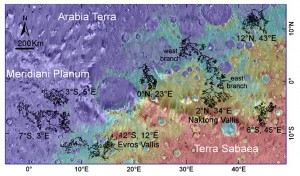Networks of valleys cross much of the ancient surface of Mars, and along with deltas and other features these all show that the environment once warm and wet enough to sustain liquid water at the surface. But when? And for how long?

WHERE WATER FLOWED. Valley networks cut across many parts of Mars, testifying to an early period when the environment was warmer and wetter than today's. But it didn't last long: 100,000 to perhaps 10 million years, says a new research report. (Image is Figure 1 from the paper.)
Concerning the When, the number of craters found in Martian valley networks suggest these formed around the late Noachian to early Hesperian eras, roughly 3.5 to 3.8 billion years ago.
As to How long, a group of scientists led by Monica Hoke (University of Colorado) studied seven large Martian valley networks to calculate how long it took to erode them. They then used this figure as a way to set bounds on how long that warm-and-wet period lasted.
The result, published in Earth and Planetary Science Letters (September 29, 2011) shows the period was brief in geologic terms, something like 100,000 to 10 million years.
Despite uncertainties in how fast the erosion would occur, the team says, “The amount of time required to form these large valley networks does not extend valley formation earlier than the Late Noachian.” The results, they say, also fit with ideas that valley-making was constrained to the Noachian–Hesperian transition in geologic time.








